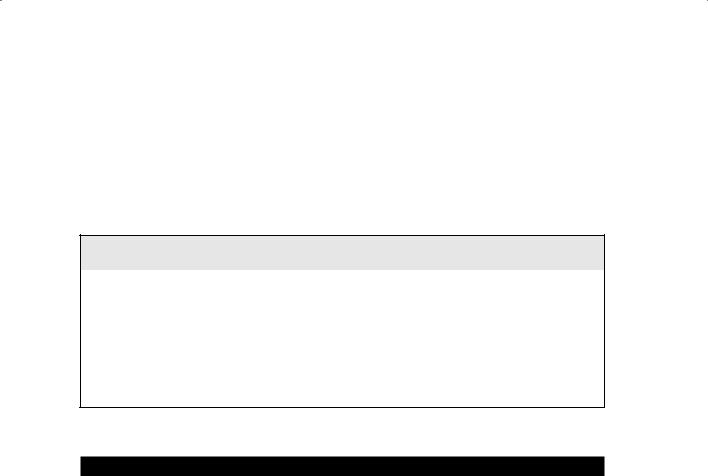
- •Acknowledgments
- •About the Author
- •Contents at a Glance
- •Contents
- •Table of Exercises
- •Introduction
- •Assessment Test
- •Answers to Assessment Test
- •Defining Ethical Hacking
- •How to Be Ethical
- •Keeping It Legal
- •Summary
- •Exam Essentials
- •Review Questions
- •Answers to Review Questions
- •Reconnaissance
- •Information-Gathering Methodology
- •Social Engineering
- •Summary
- •Exam Essentials
- •Review Questions
- •Answers to Review Questions
- •Scanning
- •Enumeration
- •Summary
- •Exam Essentials
- •Review Questions
- •Answers to Review Questions
- •The Simplest Way to Get a Password
- •Types of Passwords
- •Cracking a Password
- •Understanding Keyloggers and Other Spyware Technologies
- •Escalating Privileges
- •Understanding Rootkits
- •Hiding Files
- •Understanding Steganography Technologies
- •Summary
- •Exam Essentials
- •Review Questions
- •Answers to Review Questions
- •Trojans and Backdoors
- •Viruses and Worms
- •Summary
- •Exam Essentials
- •Review Questions
- •Answers to Review Questions
- •How a Sniffer Works
- •Sniffing Countermeasures
- •Bypassing the Limitations of Switches
- •Wireshark Filters
- •Summary
- •Exam Essentials
- •Review Questions
- •Answers to Review Questions
- •Denial of Service
- •Session Hijacking
- •Summary
- •Exam Essentials
- •Review Questions
- •Answers to Review Questions
- •How Web Servers Work
- •Types of Web Server Vulnerabilities
- •Web Application Vulnerabilities
- •Summary
- •Exam Essentials
- •Review Questions
- •Answers to Review Questions
- •SQL Injection
- •Buffer Overflows
- •Summary
- •Exam Essentials
- •Review Questions
- •Answers to Review Questions
- •Wi-Fi and Ethernet
- •Authentication and Cracking Techniques
- •Using Wireless Sniffers to Locate SSIDs
- •MAC Filters and MAC Spoofing
- •Rogue Access Points
- •Wireless Hacking Techniques
- •Securing Wireless Networks
- •Summary
- •Exam Essentials
- •Review Questions
- •Answers to Review Questions
- •Components of Physical Security
- •Understanding Physical Security
- •Physical Site Security Countermeasures
- •What to Do After a Security Breach Occurs
- •Summary
- •Exam Essentials
- •Review Questions
- •Answers to Review Questions
- •Linux Basics
- •Compiling a Linux Kernel
- •GCC Compilation Commands
- •Installing Linux Kernel Modules
- •Linux Hardening Methods
- •Summary
- •Exam Essentials
- •Review Questions
- •Answers to Review Questions
- •Types of IDSs and Evasion Techniques
- •Summary
- •Exam Essentials
- •Review Questions
- •Answers to Review Questions
- •Generating Public and Private Keys
- •Cryptography Algorithms
- •Summary
- •Exam Essentials
- •Review Questions
- •Answers to Review Questions
- •Defining Security Assessments
- •Penetration Testing
- •Pen Test Deliverables
- •Summary
- •Exam Essentials
- •Review Questions
- •Answers to Review Questions
- •Glossary
- •Index

102 Chapter 4 n System Hacking
Dumpster diving hackers look through the trash for information such as passwords, which may be written down on a piece of paper. Again, security awareness training on shredding important documents can prevent a hacker from gathering passwords by dumpster diving.
Cracking a Password
Manual password cracking involves attempting to log on with different passwords. The hacker follows these steps:
1.Find a valid user account (such as Administrator or Guest).
2.Create a list of possible passwords.
3.Rank the passwords from high to low probability.
4.Key in each password.
5.Try again until a successful password is found.
A hacker can also create a script file that tries each password in a list. This is still considered manual cracking, but it’s time consuming and not usually effective.
A more efficient way of cracking a password is to gain access to the password file on a system. Most systems hash (one-way encrypt) a password for storage on a system. During the logon process, the password entered by the user is hashed using the same algorithm and then compared to the hashed passwords stored in the file. A hacker can attempt to gain access to the hashing algorithm stored on the server instead of trying to guess or otherwise identify the password. If the hacker is successful, they can decrypt the passwords stored on the server.
Passwords are stored in the Security Accounts Manager (SAM) file on a Windows system and in a password shadow file on a Linux system.
Hacking Tools
Legion automates the password guessing in NetBIOS sessions. Legion scans multiple IP address ranges for Windows shares and also offers a manual dictionary attack tool.
NTInfoScan is a security scanner for NT 4.0. This vulnerability scanner produces an HTML-based report of security issues found on the target system and other information.
L0phtCrack is a password auditing and recovery package distributed by @stake software, which is now owned by Symantec. It performs Server Message Block (SMB) packet captures on the local network segment and captures individual login sessions. L0phtCrack contains dictionary, brute-force, and hybrid attack capabilities. Symantec has recently stopped development of the L0phtCrack tool, but it can still be found on the Internet.

Cracking a Password |
103 |
LC5 is another good password cracking tool. LC5 is a suitable replacement for L0phtCrack.
John the Ripper is a command-line tool designed to crack both Unix and NT passwords. The cracked passwords are case insensitive and may not represent the real mixed-case password.
KerbCrack consists of two programs: kerbsniff and kerbcrack. The sniffer listens on the network and captures Windows 2000/XP Kerberos logins. The cracker can be used to find the passwords from the capture file using a brute-force attack or a dictionary attack.
Understanding the LAN Manager Hash
Windows 2000 uses NT LAN Manager (NTLM) hashing to secure passwords in transit on the network. Depending on the password, NTLM hashing can be weak and easy to break. For example, let’s say that the password is 123456abcdef. When this password is encrypted with the NTLM algorithm, it’s first converted to all uppercase: 123456ABCDEF. The password is padded with null (blank) characters to make it 14 characters long: 123456ABCDEF__. Before the password is encrypted, the 14-character string is split in half: 123456A and BCDEF__. Each string is individually encrypted, and the results are concatenated:
123456A = 6BF11E04AFAB197F BCDEF__ = F1E9FFDCC75575B15
The hash is 6BF11E04AFAB197FF1E9FFDCC75575B15.
The first half of the password contains alphanumeric characters; L0phtCrack will take 24 hours to crack this part. The second half contains only letters and symbols and will take 60 seconds to crack. This is because there are many fewer combinations in the second half of the hashed password. If the password is seven characters or fewer, the second half of the hash will always be AAD3B435B51404EE.
Cracking Windows 2000 Passwords
The SAM file in Windows contains the usernames and hashed passwords. It’s located in the Windows\system32\config directory. The file is locked when the operating system is running so that a hacker can’t attempt to copy the file while the machine is booted to Windows.
One option for copying the SAM file is to boot to an alternate operating system such as DOS or Linux with a boot CD. Alternately, the file can be copied from the repair directory. If a system administrator uses the RDISK feature of Windows to back up the system,

104 Chapter 4 n System Hacking
then a compressed copy of the SAM file called SAM._ is created in C:\windows\repair. To expand this file, use the following command at the command prompt:
C:\>expand sam._ sam
After the file is uncompressed, a dictionary, hybrid, or brute-force attack can be run against the SAM file using a tool like L0phtCrack. A similar tool to L0phtcrack is Ophcrack. Exercise 4.1 illustrates how to use Ophcrack to crack passwords.
Hacking Tools
Win32CreateLocalAdminUser is a program that creates a new user with the username and password X and adds the user to the local administrator’s group. This action is part of the Metasploit Project and can be launched with the Metasploit framework on Windows.
Offline NT Password Resetter is a method of resetting the password to the administrator’s account when the system isn’t booted to Windows. The most common method is to boot to a Linux boot CD and then access the NTFS partition, which is no longer protected, and change the password.
E x e r c i s e 4 .1
Use Ophcrack to Crack Passwords
1.Download and install ophcrack from http://ophcrack.sourceforge.net/.
2.Run the ophcrack program and set the number of threads under the Preferences tab to the number of cores of the computer running ophcrack plus one. If you change this value, you have to exit ophcrack and restart it in order to save the change.
Note: This step is optional but will speed up the cracking process.
3.Click the Load button to add hashes. There are numerous ways to add the hashes:
NN |
Enter the hash manually (Single Hash option) |
NNImport a text file containing hashes you created with pwdump, fgdump, or similar third-party tools (PWDUMP File option)
NN |
Extract the hashes from the SYSTEM and SAM files (Encrypted SAM option) |
NN |
Dump the SAM from the computer ophcrack is running on (Local SAM option) |
NN |
Dump the SAM from a remote computer (Remote SAM option) |

Cracking a Password |
105 |
E x e r c i s e 4 .1 ( c o n t i n u e d )
Note: For the Encrypted SAM option, the SAM is located under the Windows system32/config directory and can only be accessed for a Windows partition that is not running. For the Local SAM and Remote SAM options, you must be logged in with the administrator rights on the computer you want to dump the SAM.
4.Click the Tables button.
5.Click the enable (green and yellow) buttons.
6.Using the up and down arrows, sort the rainbow tables you are going to use. Keep in mind that storing the rainbow tables on a fast medium like a hard disk will significantly speed up the cracking process.
7.Click the Crack button to start the cracking process. You’ll see the progress of the cracking process in the bottom boxes of the ophcrack window. When a password is found, it will be displayed in the NT Pwd field. You can save the results of a cracking session at any time by clicking the Save button.
Redirecting the SMB Logon to the Attacker
Another way to discover passwords on a network is to redirect the Server Message Block (SMB) logon to an attacker’s computer so that the passwords are sent to the hacker. In order to do this, the hacker must sniff the NTLM responses from the authentication server and trick the victim into attempting Windows authentication with the attacker’s computer. A common technique is to send the victim an email message with an embedded link to a fraudulent SMB server. When the link is clicked, the user unwittingly sends their credentials over the network.
SMBRelay An SMB server that captures usernames and password hashes from incoming SMB traffic. SMBRelay can also perform man-in-the-middle (MITM) attacks.
SMBRelay2 Similar to SMBRelay but uses NetBIOS names instead of IP addresses to capture usernames and passwords.
pwdump2 A program that extracts the password hashes from a SAM file on a Windows system. The extracted password hashes can then be run through L0phtCrack to break the passwords.
Samdump Another program that extracts NTLM hashed passwords from a SAM file.
C2MYAZZ A spyware program that makes Windows clients send their passwords as cleartext. It displays usernames and their passwords as users attach to server resources.

106 Chapter 4 n System Hacking
SMB Relay MITM Attacks and Countermeasures
An SMB relay MITM attack is when the attacker sets up a fraudulent server with a relay address. When a victim client connects to the fraudulent server, the MITM server intercepts the call, hashes the password, and passes the connection to the victim server. Figure 4.1 illustrates such an attack.
F i gu r e 4 .1 SMB relay MITM attack
|
|
|
|
|
|
|
|
|
|
|
|
|
|
|
|
|
|
|
|
|
|
|
|
|
|
|
|
|
|
|
|
|
|
|
|
|
|
|
|
|
|
|
|
|
|
|
|
|
|
|
|
|
|
|
|
|
|
|
|
|
|
|
|
|
|
|
|
|
|
|
|
|
|
|
|
|
|
|
|
|
|
|
|
|
|
|
|
|
|
Victim Client |
Man-in-the-Middle |
|||||||
Victim Server
Relay Address
Attacker
SMB relay countermeasures include configuring Windows 2000 to use SMB signing, which causes it to cryptographically sign each block of SMB communications.
Hacking Tools
SMBGrind increases the speed of L0phtCrack sessions on sniffer dumps by removing duplication and providing a way to target specific users without having to edit the dump files manually.
The SMBDie tool crashes computers running Windows 2000, XP, or NT by sending specially crafted SMB requests.
NBTdeputy can register a NetBIOS computer name on a network and respond to NetBIOS over TCP/IP (NetBT) name-query requests. It simplifies the use of SMBRelay. The relay can be referred to by computer name instead of IP address.

Cracking a Password |
107 |
NetBIOS DoS Attacks
A NetBIOS denial-of-service (DoS) attack sends a NetBIOS Name Release message to the NetBIOS Name Service on a target Windows systems and forces the system to place its name in conflict so that the name can no longer be used. This essentially blocks the client from participating in the NetBIOS network and creates a network DoS for that system.
Hacking Tool
NBName can disable entire LANs and prevent machines from rejoining them. Nodes on a NetBIOS network infected by the tool think that their names are already in use by other machines.
Another way to create a more secure and memorable password is to follow a repeatable pattern, which will enable to password to be re-created when needed.
1.Start with a memorable phrase, such as Maryhadalittlelamb
2.Change every other character to uppercase, resulting in MaRyHaDaLiTtLeLaMb
3.Change a to @ and i to 1 to yield M@RyH@D@L1TtLeL@Mb
4.Drop every other pair to result in a secure repeatable password or M@H@L1LeMb
Now you have a password that meets all the requirements, yet can be “remade” if necessary.
Password-Cracking Countermeasures
The strongest passwords possible should be implemented to protect against password cracking. Systems should enforce 8–12-character alphanumeric passwords. The length of time the same password should be used is discussed in the next section.
To protect against cracking of the hashing algorithm for passwords stored on the server, you must take care to physically isolate and protect the server. The system administrator can use the SYSKEY utility in Windows to further protect hashes stored on the server’s hard disk. The server logs should also be monitored for brute-force attacks on user accounts.

108 Chapter 4 n System Hacking
A system administrator can implement the following security precautions to decrease the effectiveness of a brute-force password-cracking attempt:
NN |
Never leave a default password. |
|
|
NN |
Never use a password that can be found in a dictionary. |
NNNever use a password related to the hostname, domain name, or anything else that can be found with Whois.
NN |
Never use a password related to your hobbies, pets, relatives, or date of birth. |
|
NNAs a last resort, use a word that has more than 21 characters from a dictionary as a password.
This subject is discussed further in the section “Monitoring Event Viewer Logs,” later in this chapter.
In the following sections, we’ll look at two measures you can take to strengthen passwords and prevent password-cracking.
Password Change Interval
Passwords should expire after a certain amount of time so that users are forced to change them. If the password interval is set too low, users will forget their current passwords; as a result, a system administrator will have to reset users’ passwords frequently. On the other hand, if passwords are allowed to be used for too long, security may be compromised. The recommended password-change interval is every 30 days. In addition, most security professionals recommended that users not be allowed to reuse the last three passwords.
You cannot completely block brute-force password attacks if the hacker switches the proxy server where the source packet is generated. A system administrator can only add security features to decrease the likelihood that brute-force password attacks will be useful.
Monitoring Event Viewer Logs
Administrators should monitor Event Viewer logs to recognize any intrusion attempts either before they take place or while they’re occurring. Generally, several failed attempts are logged in the system logs before a successful intrusion or password attack. The security logs are only as good as the system administrators who monitor them.
Tools such as VisualLast aid a network administrator in deciphering and analyzing the security log files. VisualLast provides greater insight into the NT event logs so the administrator can assess the activity of the network more accurately and efficiently. The program is designed to allow network administrators to view and report individual users’ logon and
